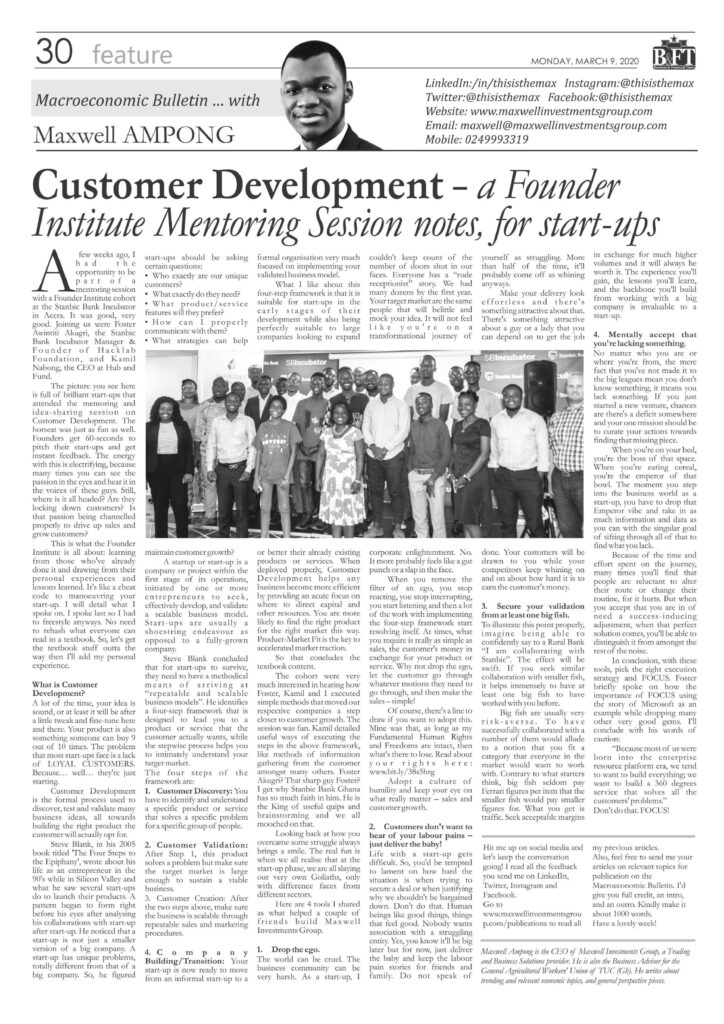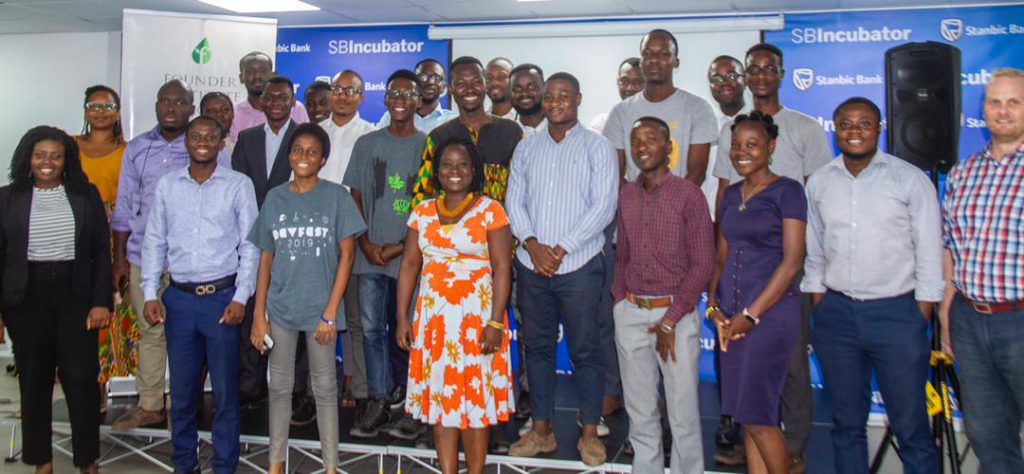
A few weeks ago, I had the opportunity to be part of a mentoring session with a Founder Institute cohort at the Stanbic Bank Incubator in Accra. It was good, very good. Joining us were Foster Awintiti Akugri, the Stanbic Bank Incubator Manager & Founder of Hacklab Foundation, and Kamil Nabong, the CEO at Hub and Fund.
The picture you see here is full of brilliant start-ups that attended the mentoring and idea-sharing session on Customer Development. The hotseat was just as fun as well. Founders get 60-seconds to pitch their start-ups and get instant feedback. The energy with this is electrifying, because many times you can see the passion in the eyes and hear it in the voices of these guys. Still, where is it all headed? Are they locking down customers? Is that passion being channelled properly to drive up sales and grow customers?
This is what the Founder Institute is all about: learning from those who’ve already done it and drawing from their personal experiences and lessons learned. It’s like a cheat code to manoeuvring your start-up. I will detail what I spoke on. I spoke last so I had to freestyle anyways. No need to rehash what everyone can read in a textbook. So, let’s get the textbook stuff outta the way then I’ll add my personal experience.
What is Customer Development?
A lot of the time, your idea is sound, or at least it will be after a little tweak and fine-tune here and there. Your product is also something someone can buy 9 out of 10 times. The problem that most start-ups face is a lack of LOYAL CUSTOMERS. Because… well… they’re just starting.
Customer Development is the formal process used to discover, test and validate many business ideas, all towards building the right product the customer will actually opt for.
Steve Blank, in his 2005 book titled ‘The Four Steps to the Epiphany’, wrote about his life as an entrepreneur in the 90’s while in Silicon Valley and what he saw several start-ups do to launch their products. A pattern began to form right before his eyes after analysing his collaborations with start-up after start-up. He noticed that a start-up is not just a smaller version of a big company. A start-up has unique problems, totally different from that of a big company. So, he figured start-ups should be asking certain questions:
- Who exactly are our unique customers?
- What exactly do they need?
- What product/service features will they prefer?
- How can I properly communicate with them?
- What strategies can help maintain customer growth?
A startup or start–up is a company or project within the first stage of its operations, initiated by one or more entrepreneurs to seek, effectively develop, and validate a scalable business model. Start-ups are usually a shoestring endeavour as opposed to a fully-grown company.
Steve Blank concluded that for start-ups to survive, they need to have a methodical means of arriving at “repeatable and scalable business models”. He identifies a four-step framework that is designed to lead you to a product or service that the customer actually wants, while the stepwise process helps you to intimately understand your target market.
The four steps of the framework are:
- Customer Discovery: You have to identify and understand a specific product or service that solves a specific problem for a specific group of people.
- Customer Validation: After Step 1, this product solves a problem but make sure the target market is large enough to sustain a viable business.
- Customer Creation: After the two steps above, make sure the business is scalable through repeatable sales and marketing procedures.
- Company Building/Transition: Your start-up is now ready to move from an informal start-up to a formal organisation very much focused on implementing your validated business model.
What I like about this four-step framework is that it is suitable for start-ups in the early stages of their development while also being perfectly suitable to large companies looking to expand or better their already existing products or services. When deployed properly, Customer Development helps any business become more efficient by providing an acute focus on where to direct capital and other resources. You are more likely to find the right product for the right market this way. Product-Market Fit is the key to accelerated market traction.
So that concludes the textbook content.
The cohort were very much interested in hearing how Foster, Kamil and I executed simple methods that moved our respective companies a step closer to customer growth. The session was fun. Kamil detailed useful ways of executing the steps in the above framework, like methods of information gathering from the customer amongst many others. Foster Akugri? That sharp guy Foster? I get why Stanbic Bank Ghana has so much faith in him. He is the King of useful quips and brainstorming and we all mooched on that.
Looking back at how you overcame some struggle always brings a smile. The real fun is when we all realise that at the start-up phase, we are all slaying our very own Goliaths, only with difference faces from different sectors.
Here are 4 tools I shared as what helped a couple of friends build Maxwell Investments Group.
1. Drop the ego.
The world can be cruel. The business community can be very harsh. As a start-up, I couldn’t keep count of the number of doors shut in our faces. Everyone has a “rude receptionist” story. We had many dozens by the first year. Your target market are the same people that will belittle and mock your idea. It will not feel like you’re on a transformational journey of corporate enlightenment. No. It more probably feels like a gut punch or a slap in the face.
When you remove the filter of an ego, you stop reacting, you stop interrupting, you start listening and then a lot of the work with implementing the four-step framework start resolving itself. At times, what you require is really as simple as sales, the customer’s money in exchange for your product or service. Why not drop the ego, let the customer go through whatever motions they need to go through, and then make the sales – simple!
Of course, there’s a line to draw if you want to adopt this. Mine was that, as long as my Fundamental Human Rights and Freedoms are intact, then what’s there to lose. Read about your rights here: www.bit.ly/38s5hrg
Adopt a culture of humility and keep your eye on what really matter – sales and customer growth.
2. Customers don’t want to hear of your labour pains – just deliver the baby!
Life with a start-up gets difficult. So, you’d be tempted to lament on how hard the situation is when trying to secure a deal or when justifying why we shouldn’t be bargained down. Don’t do that. Human beings like good things, things that feel good. Nobody wants association with a struggling entity. Yes, you know it’ll be big later but for now, just deliver the baby and keep the labour pain stories for friends and family. Do not speak of yourself as struggling. More than half of the time, it’ll probably come off as whining anyways.
Make your delivery look effortless and there’s something attractive about that. There’s something attractive about a guy or a lady that you can depend on to get the job done. Your customers will be drawn to you while your competitors keep whining on and on about how hard it is to earn the customer’s money.
3. Secure your validation from at least one big fish.
To illustrate this point properly, imagine being able to confidently say to a Rural Bank “I am collaborating with Stanbic”. The effect will be swift. If you seek similar collaboration with smaller fish, it helps immensely to have at least one big fish to have worked with you before.
Big fish are usually very risk-averse. To have successfully collaborated with a number of them would allude to a notion that you fit a category that everyone in the market would want to work with. Contrary to what starters think, big fish seldom pay Ferrari figures per item that the smaller fish would pay smaller figures for. What you get is traffic. Seek acceptable margins in exchange for much higher volumes and it will always be worth it. The experience you’ll gain, the lessons you’ll learn, and the backbone you’ll build from working with a big company is invaluable to a start-up.
4. Mentally accept that you’re lacking something.
No matter who you are or where you’re from, the mere fact that you’ve not made it to the big leagues mean you don’t know something, it means you lack something. If you just started a new venture, chances are there’s a deficit somewhere and your one mission should be to curate your actions towards finding that missing piece.
When you’re on your bed, you’re the boss of that space. When you’re eating cereal, you’re the emperor of that bowl. The moment you step into the business world as a start-up, you have to drop that Emperor vibe and take in as much information and data as you can with the singular goal of sifting through all of that to find what you lack.
Because of the time and effort spent on the journey, many times you’ll find that people are reluctant to alter their route or change their routine, for it hurts. But when you accept that you are in of need a success-inducing adjustment, when that perfect solution comes, you’ll be able to distinguish it from amongst the rest of the noise.
In conclusion, with these tools, pick the right execution strategy and FOCUS. Foster briefly spoke on how the importance of FOCUS using the story of Microsoft as an example while dropping many other very good gems. I’ll conclude with his words of caution:
“Because most of us were born into the enterprise resource platform era, we tend to want to build everything; we want to build a 360 degrees service that solves all the customers’ problems.”
Don’t do that. FOCUS!
I hope you found this article insightful and enjoyable. Subscribe to the ‘Entrepreneur In You’ newsletter here: https://lnkd.in/d-hgCVPy.
I wish you a highly productive and successful week ahead!
♕ —- ♕ —- ♕ —- ♕ —- ♕
Disclaimer: The views, thoughts, and opinions expressed in this article are solely those of the author, Dr. Maxwell Ampong, and do not necessarily reflect the official policy, position, or beliefs of Maxwell Investments Group or any of its affiliates. Any references to policy or regulation reflect the author’s interpretation and are not intended to represent the formal stance of Maxwell Investments Group. This content is provided for informational purposes only and does not constitute legal, financial, or investment advice. Readers should seek independent advice before making any decisions based on this material. Maxwell Investments Group assumes no responsibility or liability for any errors or omissions in the content or for any actions taken based on the information provided.


